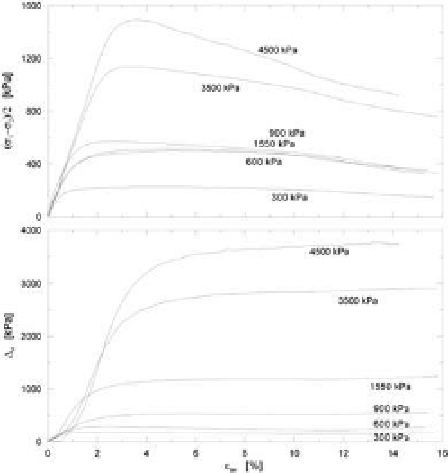Environmental Engineering Reference
In-Depth Information
The results of the drained triaxial tests are
illustrated in Figure 7. The slopes of the stress-
strain curves are much lower than in the undrained
tests and no clear peaks have developed. The ini-
tial tangent stiffness increases for higher effective
confining pressures, as is to be expected for bonded
residual soils (Maccarini, 1993). For the lower con-
finement pressures, the maximum shear stresses, at
failure, are reached at axial strains higher than 16%.
For an effective confining pressure of 3500 kPa, the
drained triaxial test renders a stress-strain curve that
increases continuously with a smooth slope, with no
clear failure developing within an axial strain of 24%.
in all cases volumetric strain decreases continuously
and hence no dilatancy is observed, contrary to what
would be expected for bonded residual soils (e.g. aversa
and evangelista, 1998; Zhu and anderson, 1998). The
final volumetric strain values show an enormous
reduction of volume during failure of between 8
and 13% for effective confining pressures ranging
between 300 and 1550 kPa, reaching almost 14% for
a confinement pressure of 3500 kPa.
rained triaxial tests show the appearance of loops
Figure 5. Void ratio versus effective confining stress
plots during the confining phase.
Figure 6.
Undrained triaxial test results for soil Rs1.
an axial strain of between 2 and 5%, and then
decrease slightly. The behaviour then further var-
ies at an axial strain of around 12% and after this
show a grater decrease for increasing axial strain.
at this same point pore pressures show a small but
continuous increase. The clear difference in the
magnitudes of samples subject to effective con-
fining stresses of 300 kPa may indicate a double
mechanism of silty-sandy soils caused by the dif-
ferent particle sizes. at higher effective confining
pressures the results show a large increase in pore
water pressure due to undrained loading, which
reach a maximum value of 3750 kPa for the maxi-
mum effective confining stress. in these cases, after
failure, strength decreases but a further variation
to the pore water pressure at higher strains, as seen
at lower confining stresses, does not occur.
Figure 7.
Drained triaxial test results for soil Rs1.
Figure 8. stress-path plots of the undrained (solid line)
and drained (dashed line) triaxial tests of soil Rs1 at low
and high confining pressures.



















